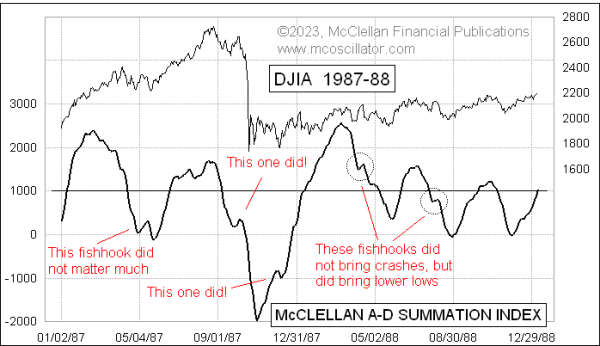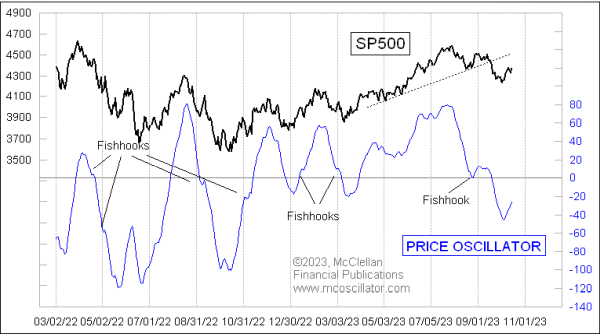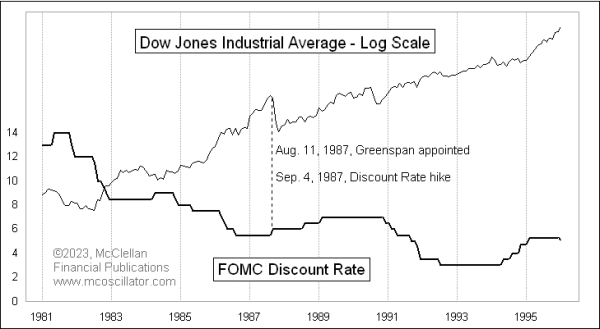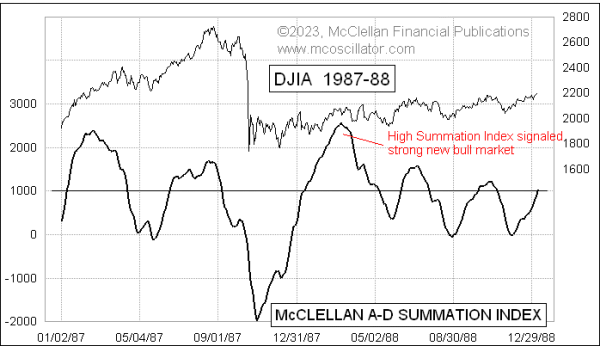Revisiting 1987 and Fishhooks

Free Chart In Focus email
Delivered to you every week
Back on Sep. 7, 2023, I wrote about a "fishhook" structure that had formed in the Price Oscillator of the SP500. A fishhook occurs when a Price Oscillator or Summation Index plot makes a temporary reversal attempt and then restarts the prior trend again. A fishhook represents a failure of the forces of reversal, and it opens the door to the prior trend resuming itself with renewed vigor.
The granddaddy of them all was the fishhook structure that formed in late September 1987, featured in the chart above. When it rolled over again, what followed was the famous crash of October 19, 1987. Fishhooks don't always lead to such big calamities, but the potential energy is there, and that is why I get excited about them.
As for the one I was sharing back on Sep. 7, here is how that one turned out:

We did not see a crash after this August 2023 fishhook, but it did have the power to produce a lower low for the SP500. And now the Price Oscillator has turned back up from a fairly low level, signaling that the bulls have the ball and the potential to run with it.
Turning back to that 1987 episode, there is a lot more to that story which many younger investors did not live through, and so they do not remember. I got permission to share the following recollections from Art Cashin, who is Director of Floor Trading at UBS, and a frequent guest on CNBC:
On this day (+1) in 1987 (that's 36 years ago, if you are burdened with a graduate degree), the NYSE had one of its most dramatic trading days in its 231-year history. It suffered its largest single day percentage loss (22%) and its largest one-day point loss up until that day (508 points). No one who was on the floor that day will ever forget it. While it was an unforgettable single day, there were months of events that went into its making.
The first two-thirds of 1987 were nothing other than spectacular on Wall Street. From New Year to shortly before Labor Day, the Dow rallied a rather stunning 43%. Fear seemed to disappear. Junior traders laughed at their cautious elders and told each other to "buy strength" rather than sell it, as each rally leg was soon followed by another. One thing that also helped banish fear was a new process called "portfolio insurance". It involved use of the newly expanded S&P futures. Somewhat counter-intuitively, it involved selling when prices turned down. The rally topped out about August 25th with the Dow hitting 2722. Interest rates had begun creeping up amid concerns of early signs of inflation. Treasury Secretary Baker began a rather open debate with the Germans on the relationship of the dollar and the Dmark. Soon the weakness in the market was turning into a visible correction. By the middle of October, the Dow fell to break an uptrend line that had protected it for over 1000 points. The flurry of takeovers and leveraged buyouts that had flourished all year
began to dry up.
On Wednesday, October 14th, there were widely discussed rumors of a new punitive tax on takeover profits. Selling turned a bit ugly and the Dow fell 96 points by the close (a record point drop at the time). The next day there was no bounce and the Dow fell another 58 points.
Friday, the 16th was an option expiration day. There was a very bad storm in London and that market closed, which forced more people to seek liquidity in New York. Stocks faced a steady wave of selling. As the close neared, rumors spread that the First Lady, Nancy Reagan, the President's right hand, might be admitted to the hospital with cancer. The selling intensified and the Dow closed down 108 points, on the low and a new record point drop.
The weekend was a rumormonger's delight. Nancy was admitted to the hospital. Japan was considering a confiscatory 96% tax on real estate speculation. Germany proposed a change in taxes on some interest rates, which would make U.S. Treasuries unattractive to Germans. Rep. Gephardt was talking about a trade bill that would freeze imports. Treasury Secretary Baker went on a Sunday talk show and openly challenged the Germans on currency. There were even rumors of U.S. planes engaging Iran.
At the time, I was running the floor for PaineWebber. Monday morning, I got up well before dawn and saw that Hong Kong was down about 10% and other markets were looking equally weak before their openings. I headed for the NYSE to check on our systems and staffing. I reached out asking the team to get in early. Once I had checked out the systems and verified staffing, I went with a partner up to the Luncheon Club for a quick coffee. With markets around the globe all down about 10%, I didn’t know if we’d get to a coffee – or anything else after we opened.
We sat about two tables away from a table where NYSE Chairman John Phelan sat with several directors and some staff. Every ten minutes or so, someone would rush up to Phelan and slip him a note or whisper in his ear. It was evident that things were deteriorating. As I headed for the floor, I went past Phelan's table, put my right arm across my chest and said – "Morituri Te Salutamus Esse". It was the gladiator's salute to the Emperor – "We, who are about to die, salute you". Phelan nodded without a smile.
The opening was not an outright disaster, but that was primarily due to the fact that many stocks did not open immediately. They were delayed, with indications to warn investors of the prices that they might open at (with hopes of inviting bargain hunters). Meanwhile, in Chicago, where you could short without a plus-tick, prices headed for freefall. Soon prices were lower in Chicago than in New York. That brought even more selling pressure to New York.
Shortly after the opening, as it became clear that this would be a very special and very dangerous day, several NYSE directors met in Chairman Phelan's office. They checked around the street to gauge any new trends in the selling pressure. They were also on the phone with the White House via former Senator Howard Baker, who was White House
Chief of Staff.
Meanwhile, back on the floor, the situation felt more unreal. Orders flowed in faster and faster, and the tape ran later and later. (The tape was linear, and the human eye can only recognize a certain number of symbols per second, 900 I think. To run faster than that would make the tape an unreadable blur. Traders can trade faster than the maximum reading speed – so the tape ran late.) One broker said it was like a bizarre dream sequence – nothing seemed real.
In late morning there were signs that the markets might begin to stabilize. Then the newly appointed Chairman of the SEC, David Ruder, was intercepted by reporters leaving a meeting at the Mayflower Hotel in Washington. Whatever they asked and whatever he said, it somehow was reported that the markets might have to be halted. Later, he would swear it was a typo, but you can't un-ring a bell. The fear of a halt sent buyers scurrying away. Stocks went into virtual freefall. The interaction with the futures saw prices melt away. The Dow closed down 508 points. One specialist, who made too good a market, ran out of funds and the firm was sold to Merrill Lynch that very night. At watering hole after watering hole, traders and specialists reported again and again how strained their resources were. Wall Street could not survive another day like this. Luckily, innkeepers, like Harry let them put the drinks on a tab.
What is often lost in the retelling is that the next day, Tuesday, was far more dangerous. It was the day that the wheels almost did come off the locomotive. The Dow opened up about 200 points Tuesday to a round of cheers on the floor. But, stocks quickly turned lower. The 200-point gain was erased, and the Dow went negative, accompanied by an audible gasp on the floor. Soon it was nearing -100 and trading was being halted in several of the Blue Chips that make up the Dow.
Then we learned that several key banks were shutting down the credit lines of market makers and NYSE specialists. The banks feared exposure to an apparently collapsing stock market.
NYSE Chairman Phelan reached out to the recently appointed head of the Fed, Alan Greenspan. Unfortunately, Greenspan was on a plane. Desperate, Phelan called the President of the New York Fed, Gerry Corrigan. He sensed the danger immediately and began calling the banks to reopen the credit lines. They were reluctant but Corrigan ultimately cajoled them. The credit lines were reopened, and the halted stocks were reopened. Best of all, the market started to rally and closed higher on the day. It was an incredible time, and the financial system was within hours (and a few phone calls) of an absolute collapse. It was a time I'll never forget.
After the crash, regulators added varying levels of circuit breakers and assured us they would prevent any repeat of the crash. Cynical traders likened the circuit breakers to lifeboats painted on the side of a ship. They were comforting and reassuring to look at but thoroughly useless in a real crisis. They were useless in the "flash crash" in May of 2010 and in the negative TARP vote selloff, and scores of other occasions. There is nothing more powerful than a free market that has changed its mind.
There are a couple of other points worth noting for the sake of history. The first is that Fed Chairman Alan Greenspan had just been appointed on August 11, 1987, two weeks before the final price top that year. And on Sep. 4, 1987, he and the FOMC raised the Fed's Discount rate from 5.5% to 6.0%, as a way for the new dog in town to mark his territory. It was the first such hike since 1984, and it did not go over well.

It is further worth noting that because of the high volume of trading on Oct. 19, 1987, the Consolidated Tape System could not handle all of the price quotes, and so the tape was running as much as 90 minutes behind real time. So brokerage firms and investors around the country had no real idea what was happening on the trading floor unless they could get through to their representatives on the phone, and you can imagine how poorly that worked. Many traders sent in blind orders, with no idea at what price they would be executed, just because they were scared and wanted out, thus exacerbating the severity of the selloff.
I personally was not a market participant yet in 1987. I was an Army captain then, and a helicopter pilot, just freshly transferred to an installation near Frankfurt in what was then called "West" Germany. I learned about the crash while driving home on Autobahn 66, while listening to the news on Armed Forces Radio.
My father Sherman McClellan was not yet in the newsletter business in 1987 (we started that together in 1995 after I got out of the Army). But Sherman did have some institutional clients he was advising at the time, he advised them in August 1987 that it was an "important top". It was a lower Summation Index top, and a third top at that.
After the crash, the great worry among investors was that the October 1987 crash was just like the October 1929 crash, and so it was going to lead us into a new Great Depression again. But by early 1988, it was clear to Sherman that something different was going on.

The ability of the Summation Index to recover from the crash lows and push up to a nice high level told Sherman that it was not going to be a repeat of the 1929 scenario (and a continuation to the 1932 low), and he told that to his clients at the time. He also went on Gene Morgan's Charting The Market TV show on KWHY-TV, channel 22 in Los Angeles to tell Gene's viewers that it was not the start of another Great Depression, and the October and December 1987 lows should be firm ones. KWHY was the original "Business Channel", and it innovated a lot of the business news reporting features which are common today, including the scrolling ticker on the bottom of the TV screen.
Unlike in 1929, when the Fed remained tight, and Congress actually raised taxes, the Fed in 1987 threw money at the problem and told banks to keep lending and it worked. Greenspan was able to pull the market back up out of the crash that his new-in-office rate hike had helped to create, and rather than being criticized for having run the markets and the economy into a ditch, he was lauded for his expertise in pulling us all out of the ditch. As a result, Greenspan was rewarded with additional terms as Fed Chairman, serving all the way until January 2006.
Tom McClellan
Editor, The McClellan Market Report
Sep 07, 2023
Fishhooks |
Aug 26, 2022
A Signal Called Fishhook in Gold |
May 13, 2016
Strong Summation Index Promises Higher Highs |